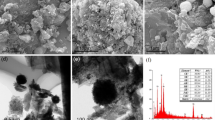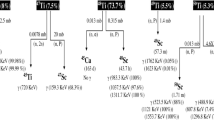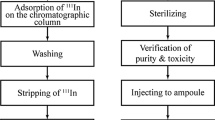Abstract
The aim of present study was to determine the efficiency of CU selective resin for separation of radionuclides Cu from large excess of Zn. Adsorption behaviors towards Cu2+ ions was investigated as function of solution pH, contact time, Cu2+ concentration, Zn2+ concentration, amount of CU resin, the effect of coexisting cation ions and the irradiation stability of CU resin. A stronger binding propensity towards Cu2+ ions over Zn2+ and excellent radiation resistance of CU resin were found, which endowed that this CU resin is capable of effectively separating radioisotopes Cu. Moreover the good separation of Cu2+ has been achieved from bulky Zn2+ using column chromatography separation. In general, the present research has confirmed the great potential application of CU resin as a more efficient column chromatography material for the separation of medical radioisotopes Cu from irradiated Zn targets.






Similar content being viewed by others
References
Qaim SM (2019) Theranostic radionuclides: recent advances in production methodologies. J Radioanal Nucl Chem 322:1257–1266
Srivastava SC (2012) Paving the way to personalized medicine: production of some theragnostic radionuclides at Brookhaven National Laboratory. Semin Nucl Med 42:151–163
Qaim SM, Scholten B, Neumaier B (2018) New developments in the production of theranostic pairs of radionuclides. J Radioanal Nucl Chem 318:1493–1509
Novak-Hofer I, Schubiger PA (2002) Copper-67 as a therapeutic nuclide for radio-immunotherapy. Eur J Nucl Med 29:821–830
Asabella AN, Cascini GL, Altini C, Paparella D, Notaristefano A, Rubini G (2014) The copper radioisotopes: a systematic review with special interest to 64Cu. Bio Med Res Int 2014:786463
Boschi A, Martini P, Janevik-Ivanovska E, Duatti A (2018) The emerging role of copper-64 radiopharmaceuticals as cancer theranostics. Drug Discov Today 23:1489–1501
Takácsa S, Aikawa M, Haba H, Komori Y, Ditrói F, Szűcs Z, Saito M, Murata T, Sakaguchi M, Ukon N (2020) Cross sections of alpha-particle induced reactions on natNi: production of 67Cu. Nucl Instrum Methods Phys Res B 479:125–136
DeNardo SJ, DeNardo GL (1983) Tumor therapy with radioactive labeled antitumor antibodies. In: Moloy PJ, Nicolson G (eds) Cell oncol: new approaches in biology, diagnosis and treatment. Praeger Press, New York, pp 282–292
Souliotis GA, Rodrigues MRD, Wang K, Iacob VE, Nica N, Roeder B, Tabacaru G, Yu M, Zanotti-Fregonara P, Bonasera A (2019) A novel approach to medical radioisotope production using inverse kinematics: a successful production test of the theranostic radionuclide 67Cu. Appl Radiat Isot 149:89–95
Ohya T, Minegishi K, Suzuki H, Nagatsu K, Fukada M, Hanyu M, Zhang MR (2019) Development of a remote purification apparatus with disposable evaporator for the routine production of high-quality 64Cu for clinical use. Appl Radiat Isot 146:127–132
Kawabata M, Motoishi S, Ohta A, Motomura A, Saeki H, Tsukada K, Hashimoto S, Iwamoto N, Nagai Y, Hashimoto K (2021) Large scale production of 64Cu and 67Cu via the 64Zn(n, p)64Cu and 68Zn(n, np/d)67Cu reactions using accelerator neutrons. J Radioanal Nucl Chem 330:913–922
Auditore L, Amato E, Baldari S (2017) Theoretical estimation of 64Cu production with neutrons emitted during 18F production with a 30MeV medical cyclotron. Appl Radiat Isot 122:229–234
Chakravarty R, Chakraborty S, Dash A (2016) 64Cu2+ ions as PET probe: an emerging paradigm in molecular imaging of cancer. Mol Pharm 13:3601–3612
Zimmermann K, Grunberg J, Honer M, Ametamey S, Schubiger PA, Novak-Hofer I (2003) Targeting of renal carcinoma with 67/64Cu-labeled anti-L1-CAM antibodychCE7: selection of copper ligands and PET imaging. Nucl Med Biol 30(4):417–427
Uddin MS, Rumman-uz-Zaman M, Hossain SM, Qaim SM (2014) Radiochemical measurement of neutron-spectrum averaged cross sections for the formation of 64Cu and 67Cu via the (n, p) reaction at a TRIGA Mark-II reactor: feasibility of simultaneous production of the theragnostic pair 64Cu/67Cu. Radiochim Acta 102:473–480
Peng F, Lu X, Janisse J, Muzik O, Shields AF (2006) PET of human prostate cancer xenografts in mice with increased uptake of 64CuCl2. J Nucl Med 47:1649
Follacchio GA, De Feo MS, De Vincentis G, Monteleone F, Liberatore M (2018) Radiopharmaceuticals labelled with copper radionuclides: clinical results in human beings. Curr Radiopharm 11(1):22–33
Knogler K, Grunberg J, Zimmermann K, Cohrs S, Honer M, Ametamey S, Altevog P, Fogel M, Schubiger PA, Novak-Hofer I (2007) Copper-67 radioimmunotherapy and growth inhibition by anti L1-cell adhesion molecule monoclonal antibodies in a therapy model of ovarian cancer metastasis. Clin Cancer Res 13(2):603–611
Jin ZH, Furukawa T, Ohya T, Degardin M, Sugyo A, Tsuji AB, Fujibayashi Y, Zhang MR, Higashi T, Boturyn D, Dumy P, Saga T (2017) 67Cu-Radiolabeling of a multimeric RGD peptide for αVβ3 integrin-targeted radionuclide therapy: stability, therapeutic efficacy, and safety studies in mice. Nucl Med Commun 38(4):347–355
Smith NA, Bowers DL, Ehst DA (2012) The production, separation, and use of 67Cu for radioimmunotherapy: a review. Appl Radiat Isot 70:2377–2383
Bokhari TH, Mushtaq A, Khan IU (2010) Production of low and high specific activity 64Cu in a reactor. J Radioanal Nucl Chem 284:265–271
McCarthy DW, Shefer RE, Klinkowstein RE, Bass LA, Margeneau WH, Cutler CS, Anderson CJ, Welch MJ (1997) Efficient production of high specific activity 64Cu using a biomedical cyclotron. Nucl Med Biol 24:35–43
Van So Le, Pellegrini P, Katsifis A, Howse J, Greguric I (2008) Radiochemical separation and quality assessment for the 68Zn target based 64Cu radioisotope production. J Radioanal Nucl Chem 277(2):451–466
Johnsen AM, Heidrich BJ, Durrant CB, Bascom AJ, Ünlü K (2015) Reactor production of 64Cu and 67Cu using enriched zinc target material. J Radioanal Nucl Chem 305:61–71
Katabuchi T, Watanabe S, Ishioka NS, Iida Y, Hanaoka H, Endo K, Matsuhashi S (2008) Production of 67Cu via the 68Zn(p, 2p)67Cu reaction and recovery of 68Zn target. J Radioanal Nucl Chem 277(2):467–470
Pupillo G, Sounalet T, Michel N, Mou L, Esposito J, Hadda F (2018) New production cross sections for the theranostic radionuclide 67Cu. Nucl Instrum Methods Phys Res B 415:41–47
Sen N, Chakravarty R, Singh KK, Chakraborty S, Shenoy KT (2021) Selective separation of Cu from large excess of Zn using a microfluidic platform. Chem Eng Process Process Intensif 159:108215
Fan X, Parker DJ, Smith MD, Ingram A, Yang Z, Seville JPK (2006) A simple and selective method for the separation of Cu radioisotopes from nickel. Nucl Med Biol 33:939–944
Kawabata M, Hashimoto K, Saeki H, Sato MS, Takakura K, Konno C, Nagai Y (2015) Production and separation of 64Cu and 67Cu using 14 MeV neutrons. J Radioanal Nucl Chem 303:1205–1209
Kim JY, Park H, Lee JC, Kim KM, Lee KC, Ha HJ, Choi TH, An G II, Cheon GJ (2009) A simple Cu-64 production and its application of Cu-64 ATSM. Appl Radiat Isot 67:1190–1194
Toyota T, Hanafusa T, Oda T, Koumura I, Sasaki T, Matsuura E, Kumon H, Yano T, Ono T (2013) A purification system for 64Cu produced by a biomedical cyclotron for antibody PET imaging. J Radioanal Nucl Chem 298:295–300
Dasgupta AK, Mausner LF, Srivastava SC (1991) A new separation procedure for 67Cu from proton irradiated Zn. Int J Rad Appl Instrum A 42(4):371–376
Rebeles RA, Van den Winkel P, Hermanne A, De VL, Waegeneer R (2010) PC-controlled radiochemistry system for preparation of no-carrier-added 64Cu. J Radioanal Nucl Chem 286:655–659
Schwarzbach R, Zimmermann K, Blauenstein P, Smith A, Schubiger PA (1995) Development of a simple and selective separation of Cu-67 from irradiated zinc for use in antibody labeling—a comparison of methods. Appl Radiat Isot 46(5):329–336
Medvedev DG, Mausner LF, Meinken GE, Kurczak SO, Schnakenberg H, Dodge CJ, Korach EM, Srivastava SC (2012) Development of a large scale production of 67Cu from 68Zn at the high energy proton accelerator: closing the 68Zn cycle. Appl Radiat Isot 70:423–429
Dirks C, Scholten B, Happel S, Zulauf A, Bombard A, Jungclas H (2010) Characterisation of a Cu selective resin and its application to the production of 64Cu. J Radioanal Nucl Chem 286:671–674
Aliev RA, Belyshev SS, Kuznetsov AA, Dzhilavyan LZ, Khankin VV, Yu AG, Kazakov AG, Priselkova AB, Kalmykov SN, Ishkhanov BS (2019) Photonuclear production and radiochemical separation of medically relevant radionuclides: 67Cu. J Radioanal Nucl Chem 321:125–132
Zhao BH, Jiang HB, Lin ZK, Xu SF, Xie J, Zhang AP (2019) Preparation of acrylamide/acrylic acid cellulose hydrogels for the adsorption of heavy metal ions. Carbohydr Polym 224:115022
Dong Z, Yuan WJ, Li Y, Hua R, Zhao L (2019) Radiation synthesis of crown ether functionalized microcrystalline cellulose as bifunctional adsorbent: a preliminary investigation on its application for removal of ReO4- as analogue for TcO4-. Radiat Phys Chem 159:147–153
Acknowledgements
This research is supported by Competitive projects of the special fund for the guidance of the innovation and development of science and technology, Gansu Province. (Investigation on Preparation and Separation technology of the Medical Isotope based on the high-current Accelerator)
Author information
Authors and Affiliations
Corresponding authors
Additional information
Publisher's Note
Springer Nature remains neutral with regard to jurisdictional claims in published maps and institutional affiliations.
Rights and permissions
About this article
Cite this article
Fan, FL., Li, HW., Cheng, NW. et al. Selective adsorption and separation of Cu(II) from Zn solution by CU resin. J Radioanal Nucl Chem 331, 1381–1388 (2022). https://doi.org/10.1007/s10967-022-08191-7
Received:
Accepted:
Published:
Issue Date:
DOI: https://doi.org/10.1007/s10967-022-08191-7




